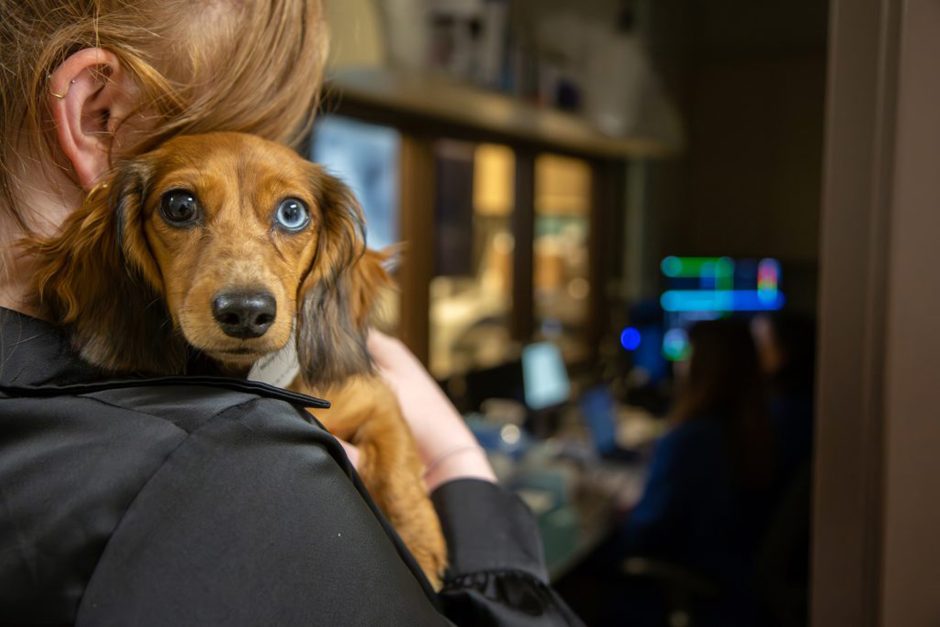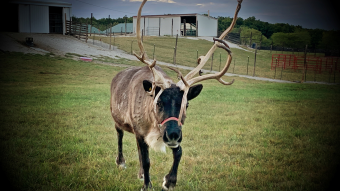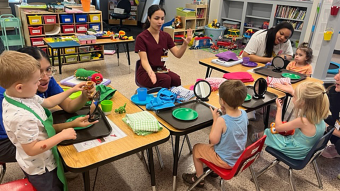
Aug. 12, 2025
Photo by Karen Clifford
At just six months old, Kallie the dachshund was struggling. Eating left her gagging. Drinking filled her with air. Multiple bouts of aspiration pneumonia had taken a toll on her four-pound body.
Specialist after specialist failed to deliver a definitive diagnosis, recommendations for additional tests or treatment options. Their only solution?
Euthanasia.
But Kallie’s owners weren’t ready to give up. As nurse practitioners, Floridians Nitra and Jason Welch knew there had to be more they could do. Weeks of research led them to just two veterinary centers in the country with experience in swallowing disorders like Kallie’s.
One response — quick, compassionate and clear — came from the University of Missouri College of Veterinary Medicine.
“From that very first email, I knew we’d found someone who actually cared and believed there might be another way,” Nitra Welch said. “That’s why we decided to pack our bags and make the trip to Missouri.”
Coordinated care, life-changing results
At Mizzou, Kallie’s case landed with Aida Vientós-Plotts, co-founder and co-director of the BREATHE Clinic, a nationally distinctive program housed within the Veterinary Health Center at the College of Veterinary Medicine. The clinic is built for complex respiratory and aerodigestive cases like Kallie’s, combining advanced diagnostics with a cross-disciplinary model that brings specialists and state-of-the-art technology together under one roof — a structure few veterinary hospitals in the country can match.
That kind of collaboration didn’t just offer possibilities — it delivered answers.
In less than 24 hours, Mizzou’s team had done what no one else could: identify Kallie’s disorder and map a path forward.
“A free standing videofluoroscopic swallow test very quickly showed us that Kallie had a disorder called cricopharyngeal achalasia,” Vientós-Plotts said. “The muscle that should open her esophagus wasn’t relaxing properly, so food and water couldn’t reliably reach her stomach and were often entering her airways instead. Once we had a definitive diagnosis, our team worked across specialties to build a treatment plan and move fast. That kind of collaboration is what makes Mizzou different.”
Vientós-Plotts partnered with the soft tissue surgery team to perform a precise procedure that involved cutting the muscle at the top of Kallie’s esophagus — creating a more consistent pathway so food and water could reliably reach her stomach. The nutrition service also played a key role in Kallie’s recovery, overseeing the placement of a feeding tube and developing a custom diet plan. From diagnostics to discharge, every step was coordinated in advance — minimizing stress for the family and making it easier to manage care from out of state.
“Mizzou took care of everything and went above and beyond for Kallie,” Welch said. “From the moment we arrived, I could see how seamlessly the teams worked together. Coming from health care, I know that it’s rare to see that level of communication across departments. But at Mizzou, everyone was aligned — sharing information, anticipating our needs and working toward the same goal. I never had to ask what was happening next. They kept me informed and supported the whole way through.”
In the year since her procedure, Kallie has flourished. She’s gained weight, built strength and reclaimed her puppyhood. No more coughing fits in the night. No more aspirating water.
“She’s her spazzy, playful self,” Welch said. “The doctors at Mizzou saved her life. And now, we’ll be able to have many more years with our girl.”
Grateful for the care Kallie received, the Welches plan to support the Veterinary Health Center’s fund for swallowing and respiratory disorders, ensuring more families can access the same level of expertise, innovation and life-saving treatment Kallie received.
Read more from the Missouri College of Veterinary Medicine


